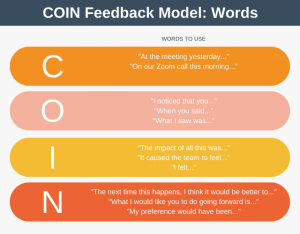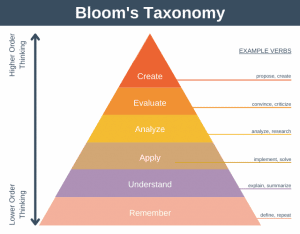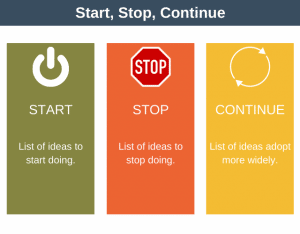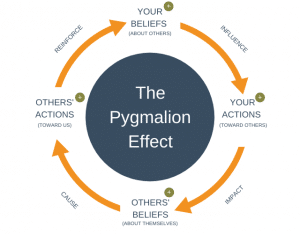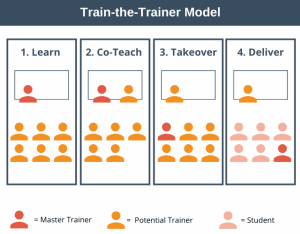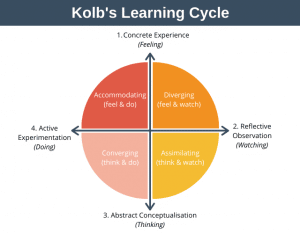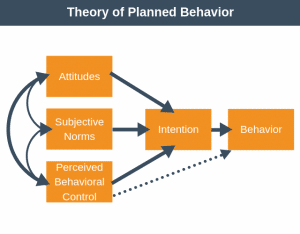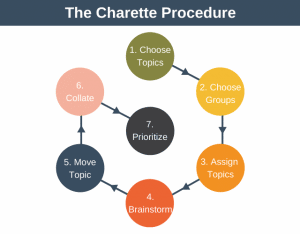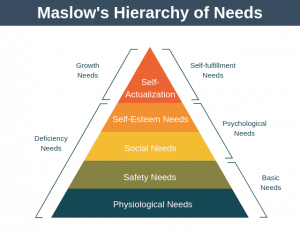The Job Characteristics Model (also know as Jobs Characteristic Theory) enables you to improve employee performance and job satisfaction by means of adjusting the job itself. The model states that if you do this successfully you can create the conditions for an employee to thrive in their role. By thrive, we mean that the employee will be motivated, perform to a high level, and be satisfied by their role.
Background
The Job Characteristics Model was developed by two organizational psychologists in the 1970s, Greg R. Oldham and J. Richard Hackman, and finalized in 1980 in their book, Work Redesign (Prentice Hall Organizational Development Series).
Earlier in the 20th century, jobs had been systematized and simplified to increase productivity and maximize production. Job Characteristics Theory (JCT) came about because the intended benefits of increased systemization often never materialized because of increased employee dissatisfaction.
These days, the Job Characteristics Model comes under the concept of work design or job design, where the emphasis is on shaping a role to satisfy the needs of both the organization and the individual.
So what is the Job Characteristics Theory? In the nutshell the theory identified 5 core job characteristics, which lead to three psychological states, which in turn lead to 4 outcomes. You can see the model in the diagram below:
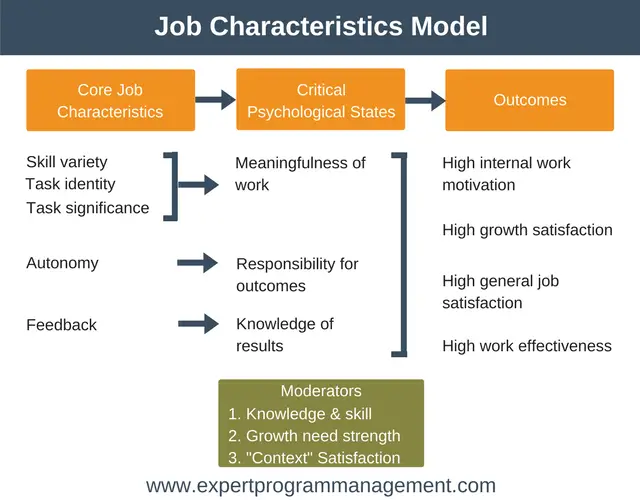
Let’s jump in and explore the model so you can get the most out of using it.
Five Core Job Characteristics
1. Skill Variety
Refers to the degree to which the job requires different skills and talents.
Think of a job that requires lots of different skills and talents, and compare that with a job that is repetitive. Job Characteristics Theory states that a job having more variety and thus requiring more skills and talents will result in an employee feeling that they are doing more meaningful work.
2. Task Identity
This refers to the degree to which the tasks of the job are clearly identifiable, and have a visible outcome.
The theory states that if the employee understands what needs to be done, understands when they are finished, and are able to see the outcome of what they achieved at the end, then they will feel that they are doing meaningful work.
Think of two workers who are part of a project to build an airplane. The first worker is involved only in the initial project planning, whereas the second worker is involved right from the initial planning through to when the first aircraft rolls off the production line. The theory states that it is the second worker who will find their work more meaningful.
3. Task significance
Refers to the degree to which the task has impact. Impact can mean a lot of different things. It could mean that the task has impact within the organization. It could mean that the task has impact to the bottom line or even to society as a whole.
Think of two employees, both part of a team building a web based software tool. The first employee is responsible for the part of the system which interacts with the user, and the second employee is responsible for ensuring data is stored efficiently behind the scenes in a database. The theory states that it is the first worker who will find the work more meaningful as they are more likely to understand the impact on the end user.
4. Autonomy
Autonomy is the degree of freedom an employee has to complete their work. It is the degree to which the employee is free to choose how to go about doing specific tasks, and the degree to which they can choose how to schedule their tasks.
The Job Characteristics Theory states that employees with more autonomy will have a greater sense of responsibility towards the results of their work, and therefore do a better job.
5. Feedback
Refers to the degree to which the employee is kept informed about how well they are doing in their role.
The theory states that more feedback leads to increased knowledge for the employee about the results of their work. If an employee is given good feedback about the work they are doing then their self-esteem will be boosted and they’ll be motivated to keep doing what they are doing (see our reward power article for further information on the power of positive feedback).
If an employee receives negative feedback quickly then this provides them the opportunity to make adjustments and corrections to their work before any major consequences are experienced.
Job Characteristics Model Equation
By combining all of these core job characteristics, Job Characteristics Theory comes up with an equation showing the potential for a given job to be motivating. NB: MPS = Motivating Potential Score.

One conclusion we can draw from this equation is that feedback and autonomy matter more to motivation than any one of skill variety, task identity, or task significance.
In essence, what this equation is trying say is that the only way for an employee to experience all three psychological states, is for the job to score highly on each of the five core job characteristics.
Moderators
As you probably already know, it simply isn’t the case that if you create a role that is high on all five core job characteristics, that every employee you then give that job to will experience all three psychological states.
Why is this? Well, it’s because we are human and we are not all wired the same. This is where the moderators come into our theory. All three moderators must score highly, in addition to the five core job characteristics being present in order for the three psychological states to be experienced.
Let’s examine each of the moderators in turn.
1. Knowledge & Skill
The knowledge and skills moderator say that if an employee has the knowledge, skill, and competence in their role then they are more likely to experience positive emotions (the three psychological states) towards their job, and their performance will improve.
Conversely, if they feel they don’t have the knowledge or skill to perform the role adequately then they will not experience the three psychological states, and they will become demotivated.
2. Growth Need Strength
Growth need strength is the degree to which an employee has the need to grow and develop. An Employee with a high growth need strength is going to be much more likely to react in a positive way to new opportunities and challenges, and thus more likely to experience the three psychological states.
Conversely, an employee with low growth need will react less positively to new opportunities and is less likely to experience the three psychological states.
3. “Context” Satisfaction
Context refers to things such as the employee’s manager, their colleagues, their pay and benefits, and job security. When an employee is satisfied with these contextual factors then they are more likely to respond positively to the challenges of their role and experience the three emotional states.
NOTE: To learn more about how an employee perceives equality in terms of context you may want to read our article about Equity Theory.
Outcomes
Finally, Job Characteristics Model states that if the five core job characteristics are in place and the three psychological states are achieved, then the following outcomes are likely to be achieved for an employee.
- High Internal Work Motivation: When an employee experiences all three of the psychological states they they are likely to be intrinsically. You can learn more about intrinsic and extrinsic motivation here.
- High Growth Satisfaction: When an employee experiences the three psychological states they are likely to feel challenged and as though they are learning through doing their job. They will feel as though this challenge is rewarding and isn’t stretching them to a point they are uncomfortable with. They will also feel supported.
- High General Job Satisfaction: Employees who experience the three psychological states are likely to experience higher job satisfaction.
- High Work Effectiveness: This can be broken down into two constituent parts. Firstly, experiencing the three psychological states will lead to workers performing a high quality of work. Secondly, it will also lead to a high quantity of work.
How to Use the Job Characteristics Model
Now that you understand Job Characteristics Theory you are in a position to use the model in one of two ways:
- To design a new roles.
- To redesign an existing role when an employee’s satisfaction or productivity is low.
Some common approaches to consider when trying to implement the Job Characteristics Model include:
1. Push tasks as low as possible
By pushing tasks as far down the organization as possible you create autonomy of task and this in turn leads to a feeling of responsibility over that task for the employee.
2. Diversify assigned tasks
By giving an employee varied tasks to perform you’ll keep their job varied and interesting as it will require a number of skills. You’ll also contribute to increased understanding by the employee as to how their work contributes to the whole (has impact).
For example, if a mechanic has responsible only for fixing car tyres then they may not understand the impact of what they do. If they are given the job of resolving all issues with the customers car and handing the keys back to the customer, then they will likely feel increased autonomy and accountability, alongside having an understanding of the impact of their work.
3. Assign work to groups
Consider assigning larger tasks to a group of employees to build, as above, an understanding of the wholeness of the product and the impact on the organization. It will also lead to increased teamwork.
4. Engage employees with customers
As in our mechanic example above, when we connect employees to customers we help employees understand the impact of their work as well as encourage accountability and showing employees how the whole comes together.
Job Characteristics Model Summary
The Job Characteristics Model is a tool which enables you to understand how the attributes of a person’s job contributes to their motivation to perform that job. You can use the tool to create a new roles that are both motivating and rewarding, or to rectify an existing role when an employee isn’t performing to the expected standard or their motivation is low.

